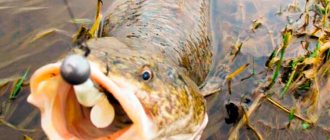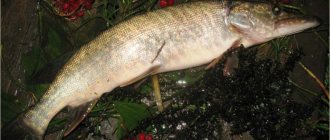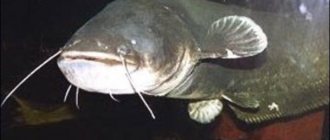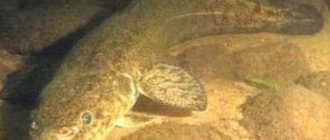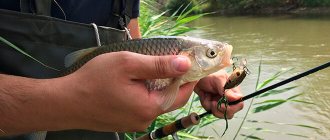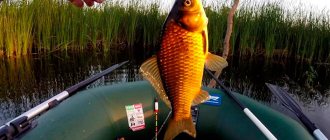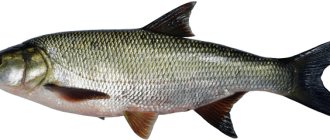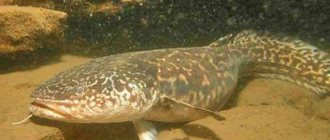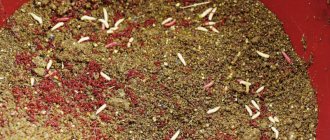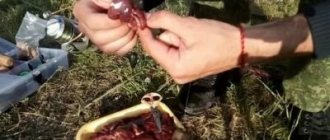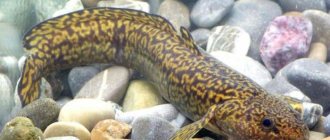Fishing for burbot in the fall is the most productive time for catching this mysterious and, to some extent, exotic fish for most of our fishermen. But the non-standard behavior of this representative of the cod fish species has made burbot hunting the least popular type of predator prey in freshwater bodies, which is not entirely justified from the point of view of the availability and simplicity of the technology for catching it.
After all, catching burbot in the fall if the angler has knowledge about its habits and habitat is not such a difficult task, but at the same time this process is both entertaining and quite interesting in terms of developing fishing strategies. We will discuss how to properly catch burbot in late autumn in the material presented to the reader below.
When does the burbot start to bite in the fall?
This predator is a cold-loving fish species and its active behavior with intensive feeding begins when the water temperature drops below 10–12 degrees. Burbot fishing in the fall begins with a drop in average daily air temperatures to around 5–8 degrees. With this fall, the water bodies quickly cool, activating the predator preparing for spawning. At the end of October, the fish begins a gradual increase in fat, which will last until spawning, towards the end of December. In contrast to the warm period of the year, in the fall burbot begins to bite steadily in the waters of the entire reservoir, without focusing on cold springs and fast tributaries of rivers. This active autumn behavior of burbot makes it less cautious, which allows it to be caught using a variety of gear, from bottom to float rigs. Fishing for burbot in late autumn is rightfully considered the golden season of burbot.
Distinctive features and distribution
In appearance, the fish is a bit like its distant relative, cod. A striking feature of the burbot is a small mustache on the lower jaw, the body is elongated, laterally compressed. The dorsal and anal fins are long, and there is also a short one on top. The color depends on the habitat and varies between dark brown and yellow shades. The ventral part is lighter from the tail to the head. The mouth is equipped with small, sandpaper-like teeth growing in one row.
The average weight of specimens that are usually caught on a hook rarely exceeds a kilogram; mostly small burbot are caught - up to 500 g. Further north in rivers such as the Yenisei, Akhtuba, Irtysh, Angara, Lena, larger specimens are found, sometimes reaching one and a half meters length and weight 15-18 kg.
Biologists' debate about the existence of different species continues to this day. Some claim that the fish is the only freshwater representative of cod, while others distinguish two more subspecies.
The predator spawns under the ice in January and February. He spends the summer in hibernation, hiding in the burrows of waterfowl rodents, snags and deep pools. It is not difficult to find the predator, it is distributed throughout the world, and this is by no means an exaggeration; it is successfully caught in Europe, Asia and even North America.
Burbot is a very common fish, and most often lives in places where the water is cold and quite clean. For this reason, the largest populations live in the Russian Federation, as well as North American countries.
Burbot is an omnivorous fish, so there should be no problems with the choice of bait; for these purposes it is very suitable:
Bunch of worms Piece of fish Live bait Shrimp Liver Leech
The best time for catching burbot is from the first days of November to the end of December (in January the burbot goes to spawn) and from the beginning of February to the end of April (post-spawning zhor). Based on the time of day, experienced fishermen have noticed that burbot begins to bite from five in the evening until six, then a break until eight (it digests food), then from eight to nine it is active again, and again a break until eleven, and then the bites continue almost until five o'clock in the morning.
Greetings, friends, dear colleagues! Today we will talk about such a desirable trophy for many as burbot. Burbot is a night hunter. To go fishing specifically for burbot, you need to prepare thoroughly: study the reservoir, study the habits of burbot and its preferences in a given period of time (winter, spring or late autumn) and wait until nightfall.
The best time for catching burbot is from the first days of November to the end of December (in January the burbot goes to spawn) and from the beginning of February to the end of April (post-spawning zhor). Based on the time of day, experienced fishermen have noticed that burbot begins to bite from five in the evening until six, then a break until eight (it digests food), then from eight to nine it is active again, and again a break until eleven, and then the bites continue almost until five o'clock in the morning.
Tips for fisherman: How to clean burbot at home - What is the difference, pros and cons
Catching burbot is an exciting activity, but at the same time difficult and painstaking. For successful fishing, you need to know its habitat. It is better if an experienced fisherman suggests the place. When searching for a place on your own, you need to pay attention to the specifics of the reservoir. River mouths, islands, stone and sand spits, trees fallen into the water, deep holes, whirlpools and current boundaries are the places where burbot can be found.
Burbot has two habits: it walks along the same path for years and stands in the same place, which fishermen call the “burbot campsite.” Therefore, if you find a trail or a burbot site, then you have secured yourself a promising place for more than one year.
The only negative: if you catch burbot not from a parking lot, where there can be dozens of them, but from a trail, then the number of burbot caught, as a rule, does not exceed 3-4 pieces, and then you can simply not waste time, but go home until the next one nights. But if you find yourself in a parking lot, the catch can amount to several dozen pieces.
But there is a small rule: burbot is very lazy, and if the bait is half a meter away from it, it will not budge, and after each catch you need to drill a new hole half a meter from the one that has already worked. It is necessary that you deliver the bait right under the nose of the burbot, which is located next to the caught one. Sometimes you have to make several holes to hit the target, and so throughout the night you drill wider and wider from the first hole.
Well, of course, when going night fishing for burbot, you need to have a large number of spare leashes. Since in most cases it is not possible to get the hook, the leash is simply cut off, and the hook is taken out during gutting.
Burbot absolutely cannot tolerate sunlight and heat, preferring cold water and icy underwater springs. The best night for catching burbot is a night with strong wind, rain or snow.
Burbot fishing is divided into three periods: spring, autumn and winter. After water bodies freeze, burbot does not show activity for about a week, but soon begins to feed abundantly before spawning. Girders are used for fishing. In most cases, in winter they use bait in the form of live bait. At this time of year, burbot is the most voracious, so it bites on almost everything: frozen fish, pieces of meat and chicken, worms, sliced fish, and any animal products.
Often in winter they use bait: meat and fish waste, poultry, animal blood. In some regions, burbot can be caught well with spoons and silicone baits. To improve the result, experienced fishermen put bait in the form of pieces of fresh fish on the spoon. Any fish is suitable as a bait: crucian carp, roach, ruff. When choosing spinners, preference is given to oscillating brass and copper models weighing from 15 to 30 grams.
Burbot is very curious and always reacts to extraneous noise and artificial light. Therefore, in winter they use the following trick from the ice: they tap the edge of the hole with a wooden stick and hang a lantern in the tent above the hole so that a ray of light penetrates into the dark abyss of the reservoir. And when fishing with a feeder in spring or late autumn in open water, a fire is lit on the shore at the edge of the water, the glare of which on the water also attracts burbot, and it approaches almost the very shore.
Spring fishing begins ten days after the ice melts and continues until mid-spring. As the water warms, the bite becomes worse and gradually disappears. From May to August it is almost impossible to catch burbot.
The most suitable gear for fishing in the spring is a feeder or a simple donka. Installation is used with an in-line sliding weight. The number of leashes is usually two or more. The main condition is that the hook of one leash does not reach the neighboring leashes, since one burbot can swallow two baits at once in turn if they lie next to each other.
As a rule, five or more feeders are used. Each feeder is cast at different distances in search of a path, but at night the burbot comes out to the shallows closer to the shore, so the distances should be from 5 to 20 meters. You can use different baits. But, according to experienced fishermen, it is at this time that it is best to use worms in large bunches of up to five pieces per hook.
Autumn fishing is similar to spring fishing, the only difference is that the frequency and quality of the bite gradually improves as cold weather approaches. At this time of year, burbot bite very often in rainy and windy weather.
Tips for fisherman: How to cook burbot deliciously in a frying pan - Choosing the best
Donks and mugs are used for fishing. Mugs bring larger catches. The most popular bait in the fall is live bait or pieces of cut fish. Less commonly used are frogs and worms. Burbot's favorite fish are small loaches, minnows, ruffes and roaches. The bite continues until the first ice forms.
The main value for a fisherman is not even the tasty meat itself (some fishermen generally disdain to eat burbot because of its predilection for carrion), the main value is the liver. Burbot is a member of the cod family, and cod liver is considered a delicacy.
Searching for burbot is indeed a very labor-intensive task, but then the found parking spot will delight you for many years.
Finally, it is necessary to mention that due to the poor survival rate of eggs (only 0.3% of the total amount of laid eggs survives), burbot is rapidly reducing its numbers in the country’s water bodies. It is practically impossible to catch burbot over a kilogram in the middle zone. These are mostly fish up to half a kilogram.
I wish you only a good mood. Bye! See you!
The luminous nod is not relevant for the knocking fishing method. When the rod is held in your hand, even a weak bite is felt well! Burbot is a predator - it swallows zealously and offers decent resistance even to an experienced fisherman.
Burbot must be quickly pulled out of the water! If you drag it slowly, it will be able to group itself and will not fit into the hole.
From personal experience, we note such places as the entrances to bays and spaces next to streams, which during the flood period connect the river with the river. It is caught on the river a little further from the stream. And in the spring, during high water, it is right in the stream itself! You need to catch it in the spring using a regular six-meter fishing rod with a jig head and live bait.
It wanders in the same areas and occupies its usual habitat every winter. Burbot stays in certain locations and they are known to fishermen. It’s better to ask the burbot fishermen to know exactly where to look for the baleen fish. It walks along paths, so the catch directly depends on which hole the fisherman occupied.
It hits both from a meter and from a depth of six meters. It climbs both in places with strong currents and in places where there is no current. It is important to have jig heads of different weights with you in order to catch bottom fish in calm and fast areas.
«>
Finding a fishing spot
Burbots lead a bottom-dwelling lifestyle, spending most of it in a certain small area of the reservoir.
Important! The fish loves pebble and rocky bottoms with different depth levels, ranging from 1 to 15 meters. Its habitat requires clean and flowing waters.
Consequently, large rivers are one of the most promising habitats for this cod population. Small fish stay in small groups in the coastal zone, moving in search of food along the same route over a long period of time. In connection with this feature of the behavior of the predator, it is important for the fisherman to find the so-called burbot trail , which will become the prey trajectory for installing gear. Large specimens, individuals over 1.5-2 kg, lead a solitary lifestyle, taking up snags near a rapid whirlpool or an underwater cold spring for shelter. The predator is strictly nocturnal, which must be taken into account when choosing a fishing strategy even after finding a promising place.
What to use to catch burbot in the fall
The main food of freshwater cod is small fish, hiding in the rocky terrain of the reservoir. When choosing bait, the fisherman needs to focus only on the animal component of the bait and preferably with a distinct odor, and the ability to release blood or meat juice only favors a good bite. Continuing the article, we will consider the main types of burbot baits that work effectively throughout the entire autumn fishing season for this fish.
Zywiec
The favorite delicacy of burbots is ruff. Despite its spiny fins, the predator most often attacks this bait among live bait fish. Good fishing results are achieved by installing minnows and bleaks. Recently, with the spread of gobies in rivers, this type of bottom fish has also become part of the predator’s diet and is successfully used by burbots at their bets. Roach and small crucian carp are also suitable for catching this fish, but with less success compared to previous options.
Important! Before installing live bait, some fishermen press down the fish until blood and meat juice begin to flow from it.
This technique helps to attract the caught fish to the fishing point with great success. For a predator, the intense movements of the prey are not as important as the specific smell of food. Most often, live bait is placed on a hook under the upper fin.
Dung or earthworms
Dung scented worms are one of the most promising baits for burbot in the autumn season. Earthworms are no less suitable for fishing, but have a less concentrated odor. Predators also respond well to water worms, but due to the delicate nature of the bait, its rigs cannot always be securely attached to the hooks, especially when fishing on currents. Selected worms are used for burbot hunting, choosing large and playful individuals.
Important! To rig a worm, use hooks with long shanks, setting the bait in a bunch of five or seven specimens, piercing the worm in the middle of the length of its body.
Pieces of fish meat
The fillet of almost all types of fish, including sea fish, is suitable for bait.
Important! The cut loin part, together with the skin, but without scales, is cut into strips up to 10 cm long and 1–2 cm thick.
After the desired strips are formed, the meat is placed in a glass jar for half a day and left at room temperature, allowing the product to release its juice. For installations, use one strip, placing it on the hook with a through puncture in the central part.
Frog
Burbot also bites on frogs, which are caught directly in the predator’s habitat. The bait is suitable for small and medium-sized individuals with clean, bump-free skin. It is worth distinguishing and not confusing a frog with a toad.
Important! Before installation, the amphibian is pressed down, drawing blood and immobilizing the bait.
The frog is hooked onto the thigh, pierced right through with a hook with a long shank.
Other attachments
Other, but promising, baits include chicken offal, including in this concept the intestines and liver of the animal, cleared of contents. Good results are obtained by fishing with beef liver, previously soaked in the animal’s blood. With the presence of mollusks such as toothless or pearl barley in the reservoir, the meat of this local inhabitant can be successfully used as bait. A long black leech that needs to be crushed before installing the rig is also suitable for fishing.
Catching burbot on a donk
The most effective tackle for burbot is the classic donka. The best option would be a bottom tackle based on a steel spinning rod and an inertial reel. It is convenient and easy to use, and does not require serious expenses for its layout.
Tips for fisherman: How to properly bait bait on burbot - How to best use
When hunting for burbot on a donk, it is customary to use several rods at the same time. They are placed close to each other so that it is convenient for the fisherman to monitor them using rod holders or feeder stands. The equipment is thrown into promising areas, closer to the shelter where a predator can stand.
Monofilament with a thickness of 0.35–0.50 mm is used as the main thread. You can wind a cord around the spool with a similar breaking force. The leash is made of fluorocarbon or monofilament fishing line of a smaller diameter. You can attach live bait, a dead fish, a large earthworm or a piece of meat to the hook of the rig.
He takes the bait confidently. Before hooking, you need to take a short pause, allowing the burbot to swallow the bait so that it does not come off during the fishing process. Once hooked, the predator does not make sudden jerks like a pike. He tries to stay at the bottom and duck under the nearest shelter. Therefore, the fish should first be moved from its place and begin to quickly reel in the fishing line, raising the equipment to the surface.
This fish is the only representative of the cod family that lives in fresh water. In fact, burbot is a great original; this fish is most active in cold water - provided, of course, there is a sufficient amount of oxygen dissolved in it. If in the south of Russia there is little burbot, and in the middle zone it rarely grows to a kilogram of live weight, then in the basins of northern rivers it is also found in gigantic sizes.
Bait for autumn burbot
To lure the predator to the fishing site, burrowers have developed a technique for preparing special bait. Bait for burbot does not include plant components and is prepared from finely chopped fish meat or the liver of any animal. The chopped product is left for 10–12 hours at room temperature until juice begins to form and is subsequently mixed with sifted earthen soil. From the resulting mix, balls are prepared already on the reservoir, which are compressed, having previously been moistened to a certain consistency, depending on the strength of the current of the reservoir.
Important! The abandoned ball should reach the bottom and then fall apart into its components, forming a feeding spot.
A useful element of bait would be live maggots, added to the mixture just before the formation of the balls.
How to catch burbot in autumn
Having decided on a promising place, the fishing itself is planned at night. The fish begins searching for prey in complete darkness. At dusk and on clear moonlit nights, the fish are inactive.
Important! Predators are most active during periods of unstable weather. Strong winds, rain and sudden changes in pressure stimulate the feeding activity of burbots.
Burbots feed from the bottom, therefore, baits are placed on the bottom base or at a distance of no more than 5 cm from it. No fires are lit on the banks in the immediate fishing areas; this stimulates the fish to escape. They try to make as little noise as possible and move along the shore only when necessary . The burbot bite looks like a single jerk followed by the alarm going off. If after ten minutes there are no repeated pulls, then you should check the bait and most likely there will be a positive result. No hooking is required; predators, having taken the bait, hide and can spend a long time without moving in one place. As a rule, the best fishing strategy is to check the gear hourly, regardless of the presence of bites.
Important! Any bite ends with a deep swallow of the bait, so it is necessary to have an extractor and pre-prepared spare leashes.
Autumn burbot fishing by month
September. Until mid-September, the summer heat is still there, so burbot is not caught on all rivers. It begins to manifest itself in the second half of the month, it can go out to feed at night, but you can count on a more or less stable bite only on cloudy and rainy days. In September it is difficult to find the location of this predator. To determine at what depth he prefers to be today, you need to use several gears at once and throw them at different distances. If for 2-3 hours not a single bite has occurred, this is a fairly convincing reason to collect the donks and change the fishing location.
October. Long rains, slush, sudden cold snaps, and strong winds are normal for mid-autumn. And the worse the weather, the more at ease the burbot feels and bites better. This month he moves more, actively searches for food and willingly takes fishermen's bait. Now you can not only search for it in promising sections of the river, but also lure it using bait. Even frozen fish from your local grocery store will do. It needs to be crushed, mixed with soil, add worms, meat from caught shellfish and you can use it. Such a tasty set will definitely arouse the interest of a fattening predator.
November. At the very end of the open water season, burbot moves further and further from the usual channel zone and increasingly visits small fish sites located near the shore. As a rule, these are the mouths of streams, canals and small rivers flowing into a large body of water. As before, it continues to avoid areas with silted bottom soil or covered with fallen leaves, so catching it under trees is an unpromising activity. The same applies to overgrown places where the grass that has sunk to the bottom is already rotting with might and main. A good choice would be the boundary of two oppositely directed currents, creating the so-called return flow. At such points, if there is also a suitable depth, you can catch up to a dozen decent burbot during a fishing trip. Video on the topic:
Zakidushki FISHING / OPENING OF THE SEASON AUTUMN 2021 / BURTOB FISHING
23:00
Burbot fishing in October | Fishing for snacks
12:16
This is how I catch Burbot. Fishing for snacks in the fall - Sick of Fishing No. 567
19:16
Catching burbot in late autumn on a donk
16:14
narybalke
Tackle for burbot in autumn
Pre-winter activity of the predator provides fishing opportunities with various types of bottom gear. Starting from the classic version of the elastic donkey and ending with equipping spinning and feeder rods with bottom mounts, burrowers conduct successful and productive hunts. The equipment is not particularly thin and delicate, since the burbot swallows the bait on the fly without tasting it, and the basis for biting is only the competent and accurate placement of the bait on the fish trail. Making tackle for catching burbot with your own hands is quite simple and inexpensive. Let's talk in more detail about some popular and simple fishing methods.
Catching a predator at night
Often in inclement weather and definitely in the dark, catching burbot on the river requires careful preparation, which can ensure both success and comfort of fishing.
The fisherman needs to take care of having a convenient place to wait for bites, equipping a tent with shelter from rain and wind during daylight hours. The installation sites for gear are cleared of branches, bushes and tall grass. After all, casting rigs at night requires special care and caution, and unnecessary interference certainly does not help this matter. Having warm clothes, a raincoat and a thermos with hot coffee will help pass the minutes of waiting between bites. Necessary equipment when burbot fishing is the presence of a reliable electric flashlight, which will help both when casting and when fishing for the caught trophy. Before leaving, do not forget to check the batteries for their functionality, and it is best to have a spare set of suitable elements.
Important! As a rule, fish activity manifests itself from the evening, from the moment of complete darkening, until two o’clock in the morning. The next surge in exits occurs between five and seven o'clock in the morning.
Features of river burbot fishing
When catching burbot, you must immediately take into account the characteristics of a particular river, its depth and the speed of the water flow. Depending on this, it is necessary to select the appropriate gear. If the river is shallow, then there is no point in using long skeins of fishing line. On the contrary, at great depths it is necessary to have a sufficiently large supply of strong fishing line. The weight of the sinker also plays a big role. If the current at the fishing site is weak, then you can use a sliding weight whose weight does not exceed 50 grams. If the river has a fairly large current, then it is better to use stationary weights, the weight of which can sometimes reach 150 grams.
Fishing for burbot on the river involves setting up bottom gear. At the same time, there are several ways to do this type of fishing. The first method involves installing a large number of gear in different places in the reservoir. After this, all gear is left overnight and checked for fish in the morning. This method of fishing is considered passive, and is not perceived as interesting by some fishermen. Another method involves the use of two donks, with the help of which it is necessary to determine the location of the burbot. And then try to catch him. Sometimes the process of searching for a fishing spot takes more time than the fishing itself, but this cannot be avoided when trying to catch burbot.
Read: Burbot in autumn. When to catch?
Burbot is a fairly voracious fish, so it completely swallows the bait. Sometimes, in order to get the hook, you even have to cut open the stomach of the fish. Thanks to this, it will definitely not fall off, and you can safely fish it ashore. The gluttony of burbot also manifests itself during periods when food is scarce. At this time, burbots can devour each other.
